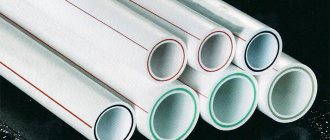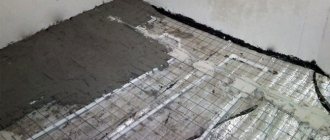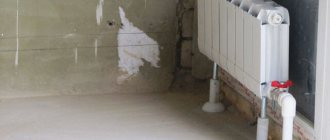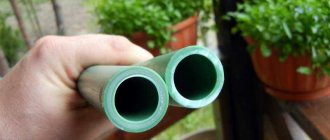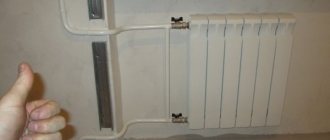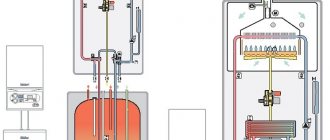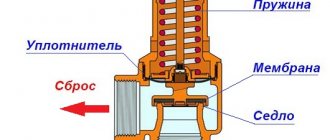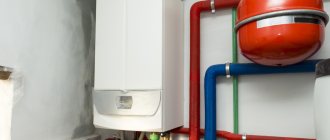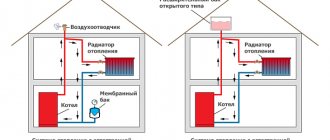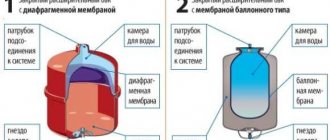- Properties of polypropylene
- Duration of guaranteed operation of polypropylene systems
- Pressure in pipelines
- Methods for installing polypropylene pipes
- Disadvantages of polypropylene systems
- Unusual properties of polypropylene
- Application of reinforced polypropylene pipes
It has long been no secret to anyone that polypropylene highways have firmly entered our lives. They are widely used for the repair and installation of plumbing and heating systems. They are especially actively used in new buildings, since open-minded people work there, and they try to introduce new technologies into life. But before you decide what to use in your home, it is important to find out what pressure the polypropylene pipe can withstand.
Of course, every reasonable owner, before installing polypropylene systems, should think about how reliable they are and whether there will be any surprises. The fact that old friends - steel and cast iron pipes - were definitely reliable, no one doubts this, but what is the situation with this new product - we need to figure it out.
Properties of polypropylene
To understand what pressure polypropylene systems are designed for, you need to take a closer look at the structure of the material itself.
Polypropylene is a soft polymer, so it does not perform reliably at very high temperatures. For him, a temperature of 140 degrees means that the surface of the pipe becomes soft, bends, and loses its shape. But if the temperature rises to 175 degrees, then the polypropylene will begin to melt.
Modern polypropylene pipes
However, it is unlikely that any of us at home have water at such a temperature in the systems at least sometimes. This means that polypropylene lines are quite suitable for use in a heating system and for supplying hot water.
What temperature can polypropylene pipes withstand?
Polypropylene is a polymer that cannot withstand overheating. At 140 °C it softens, which is why deformations are possible, at 175 °C it melts.
What temperature can a polypropylene pipe withstand? The maximum water temperature that such a pipe can transport is 95 °C. Of course, it can withstand higher temperatures, but only for a short time. If you use a polypropylene pipe for a long time to transport coolant heated to 100 °C or more, its service life is reduced significantly.
The temperature of the water circulating in heating circuits generally reaches 90 °C, and hot water heated to 65 °C is supplied in DHW systems.
Polypropylene, like many materials, changes in size when temperature changes: when heated it expands, when cooled it contracts. At maximum water temperatures, plastic pipes bend, sag and swell.
Duration of guaranteed operation of polypropylene systems
The guaranteed service life for polypropylene pipes is about fifty years. This is provided that they will be used to supply water no warmer than twenty degrees Celsius. That is, during all these years the pipeline wall will experience a constant load. The force of the load will depend on the temperature of the water flowing in it and under what pressure. It is not at all surprising that after the expiration date, the pipeline system may simply burst.
In industry, it is common to use pressure units such as technical atmospheres. So, for polypropylene systems, the normal pressure in the pipe is from four to six atmospheres. That is, if water flows in the pipeline no hotter than 75 degrees at a pressure of no more than six technical atmospheres, then under such conditions the system will last all fifty years, as written in the advertisement. And maybe even more.
Operation of polypropylene pipes
This is a considerable period of time for heating systems made of polypropylene. This means that when using polypropylene lines in the right conditions, they will serve you for a long time and faithfully.
Warranty period for polypropylene products
According to manufacturers of polypropylene pipes, they are guaranteed to last for 50 years, provided that the temperature of the liquid moving through them does not exceed plus 20 degrees.
During the entire period of operation, a constant load will be placed on the walls of the pipelines. Its strength depends on the water temperature and pressure - polypropylene pipes may burst after the expiration date.
In industry, technical atmospheres were adopted as a unit of pressure measurement. The normal value for this parameter is considered to be 4–6 atmospheres.
Thus, when the maximum temperature for polypropylene pipes is no more than 75 degrees at a pressure not exceeding 6 technical atmospheres, the system will last 50 years, and sometimes more (more: “What temperature can a polypropylene pipe withstand - theory and practice with examples”) . For heating structures made of polypropylene, this service life is quite long.
Pressure in pipelines
The system of codes and regulations strictly regulates the correct indicators for water supply systems, but when testing the start-up of new houses, more pressure is applied. As a rule, it can reach 12 atmospheres, which is twice the norm. How do polypropylene pipelines fare in such an environment? A short-term change in pressure will not affect the quality of the pipeline. In addition, when testing systems, they usually use not only water, but also air, which significantly lightens the load on the pipe walls.
Obviously, it is not recommended to use the maximum pressure of polypropylene pipes, since under such conditions the service life of the pipeline is sharply reduced. And if, along with increased pressure, increased water temperature is used, then the pipeline may even rupture, bringing a lot of inconvenience and problems. That is why, when installing polypropylene pipelines, it is necessary to carefully monitor the maximum permissible pressure on the system.
WHAT PRESSURE ARE POLYPROPYLENE PIPES DESIGNED FOR?
The marking of a polypropylene pipe carries important information about the composition of the pipe and its application. Professionals can easily read and quickly select the right pipe for water supply or heating without overpaying the customer’s money. But what to do if you yourself want to install a water supply system in your country house or house? In this article we will talk about how to correctly calculate the permissible pressure value for a polypropylene pipe and make the right choice, saving money.
Rice. 1. Marking of polypropylene pipes
What pressure is the pipe designed for:
PN10
– nominal pressure 10 atmospheres, this pipe is suitable for cold water supply with temperatures up to +20°C.
PN16
– nominal pressure 16 atmospheres, used for cold water supply and water supply with a temperature not exceeding +60°C.
PN20
– nominal pressure 20 atmospheres, used for cold and hot water supply with a recommended temperature not higher than 75 – 80°C. These pipes can also be used for heating systems with a maximum permissible temperature of 95°C, but it must be taken into account that the service life of the pipe will be noticeably shorter.
PN25
– nominal pressure is 25 atmospheres, if you see this parameter, this may mean that the pipe is reinforced with an aluminum layer and is used for hot water supply and heating systems with an operating temperature not exceeding +95°C.
Following all this data is the marking of the pipe diameter and wall thickness: for example, 20x3.4, which in translation means: 20 is the outer diameter of the pipe in mm (polypropylene pipes always indicate the outer diameter), 3.4 is the wall thickness in mm.
Also, the pipe marking may contain such data as: regulatory document, production date, batch number, etc. For different manufacturers, the marking order may differ from the above, the essence of this does not change.
We also want to pay special attention to the fact that when choosing a pipe, pay attention to its temperature and pressure graph, because all this marking with symbols PN10, PN16, PN20... is indicated at a temperature of +20°C. If your coolant temperature is +75°C, then the maximum pressure should not exceed 6 atmospheres.
Of course, you shouldn’t panic if suddenly for some reason your pressure jumps to 8 or 10 atmospheres at a given temperature, nothing will happen to the pipe, it won’t burst - it’s just that the longer the exposure to critical temperatures and pressures, the shorter the service life pipes.
Source: www.plastcom.kz
Methods for installing polypropylene pipes
Features of pressure pipes
The advantage of polypropylene pipelines is that they can be connected to each other in different ways. There are two main connection methods:
- Dozens of types of fittings are regularly produced. They are used when it is necessary to branch a highway into several channels, or when the highway turns sharply;
- a particularly popular connection of polypropylene systems by creating a monolithic system. Using a soldering iron or a special welding machine, it is easy to cut the pipe in the right place and solder it. This method of fastening pipelines is considered the most reliable, since then there is no doubt whether the polypropylene pipe will withstand the given pressure.
When someone decides to furnish their home with polypropylene systems, they calculate the required length of the pipeline, determining how much material they will need. Then it is important to find out exactly what pressure is in the line on which it is planned to install polypropylene pipes. Having decided on the diameter, it is important to be able to independently determine whether a given pipe is suitable for the conditions of this particular home. It is worth noting that the normal operating pressure of polypropylene pipes is indicated in mega-pascals. The symbol for this unit of measurement is MPa. One technical atmosphere is equal to 0.0980665 MPa, which means that for a polypropylene line this value should not exceed 0.588399 MPa.
Installation of polypropylene pipes
Features of installation and operation of polypropylene pipes
It is allowed to operate polypropylene pipes at temperatures below zero, but measures should be taken to ensure that the media in the pipe does not freeze. A frozen polymer pipe will not burst, but will last less.
During installation, pipes are connected using socket soldering and transition or connecting elements - detachable fittings. Rozma threaded fittings, as well as solder joints, retain their properties at the limiting temperatures and pressures of the pipelines being laid. To determine (confirm the manufacturer’s data) what pressure and what temperature PP pipes can withstand, they are certified - tested according to an approved method. received a certificate for polypropylene pipes confirming their compliance with STB 1293-2001 - State Standard for Polymer Pipes of the Republic of Belarus.
Rozma LLC has been producing polypropylene materials since 2003. The production technology is Czech, the equipment is from Austria, Germany, Italy. The company’s own certified laboratory constantly monitors the parameters of raw materials, as well as finished pipes and fittings. The production process is as automated as possible to eliminate the possibility of deterioration of product characteristics due to the human factor. The resulting finished product is not inferior to European-made analogues in terms of quality, mechanical and temperature characteristics, or environmental friendliness. This is evidenced not only by documents (certificates, conclusions, certificates). Every day, Rozma polypropylene products are tested by thousands of end consumers, and their constant trust is the most reliable certificate of quality.
Disadvantages of polypropylene systems
Before using polypropylene systems, it is important to consider several disadvantages of such pipes:
- polypropylene pipes cannot be bent;
- fittings for pipelines made of polypropylene do not have a very aesthetic appearance;
- when heated to high temperatures, the pipes stretch and sag, thus creating an unattractive appearance;
- When installing such pipes, it is important to monitor the operating temperature, otherwise the overheated edges of the pipeline will change their size and will differ in cross-sectional diameter from the fittings reassigned for them.
High pressure polypropylene pipes are difficult to find. The manufacturing material itself is not intended for use in such conditions. If you regularly allow increased pressure, the communication line will definitely fail.
The main reasons for choosing polypropylene pipes for the heating circuit
The reasons, which, in fact, are the advantages of polypropylene pipes are as follows:
- Polypropylene has a distinctly low weight, which greatly simplifies its delivery to the work site and installation itself - no special devices or equipment are required.
- If you have the necessary tools, polypropylene pipes are easy to install, and welding techniques can be learned very quickly.
- The manufacturing material is absolutely harmless for residential premises, since it does not change its chemical composition even with strong heating and does not emit toxic fumes into the air.
- Thanks to the stabilizers included in polypropylene, pipes can withstand water hammer and thermal loads, and even freezing of water inside without rupture.
- The smooth inner walls of the pipes promote uniform, turbulence-free and noise-free circulation of the coolant.
- Both the pipes themselves and their components are inexpensive. A wide selection of components allows for installation of a circuit of any complexity.
A little training and any owner can carry out independent installation
- A circuit made of high-quality pipes, if installed correctly, will last at least 20–30 years.
- The aesthetic appearance of the pipes makes it possible not to spoil the interior, and the contour itself usually does not require either painting or additional decoration.
So, polypropylene pipes with a reinforcing aluminum layer are excellent for heating circuits of autonomous and central systems. In addition, the installation of this material is quite simple and feasible even for people who have no experience in such work. After several training sessions on the installation of individual components, the assembly process of the entire circuit can be carried out on your own.
Unusual properties of polypropylene
By their structure, polypropylene pipelines tend to react strongly to sudden temperature changes.
When a pipe is exposed to too high temperatures, it expands. When the temperature drops, it returns to its original position.
Although in some ways this is a disadvantage, it is still a lifesaver in some situations.
Since plastic pipelines are sometimes laid underground in outdoor conditions, they are not completely protected from frost. For most systems, freezing is a disaster. However, with polypropylene lines the situation is completely different. If the water in such pipelines freezes, then nothing happens to the pipe itself. It's just expanding. When a thaw occurs, the water melts and the system returns to its original position.
Of course, whatever the consequences, freezing water in the main is an unpleasant phenomenon. Therefore, in the case of laying a polypropylene pipeline on the street, it is important to dig it to a depth that will be at least twenty centimeters more than the required norm.
When installing such pipes in multi-story buildings, it was noticed that the pressure on the first floor differs from the pressure on the last. However, this difference is small. For example, from the first to the fifth floor the pressure difference will be only 177 Pa. This is about 0.017 percent of one atmosphere. It turns out that the pressure on the first floor of a high-rise building will always be slightly higher than on other floors. However, this difference is so small that in order for it to become noticeable, a person must live from the fifth floor to the height of a skyscraper. But even there, sometimes special pumps are installed that stabilize the pressure on all floors.
Characteristics of polypropylene
A distinctive feature of polypropylene is that this soft polymer material does not tolerate high temperatures of liquid moving through the pipeline. So at 140 degrees, the surface of pipes made from it loses its shape and bends because it becomes soft. And after the temperature rises to 175 degrees, the material begins to melt.
But in residential buildings in heating systems, the coolant is never that hot. From this we can conclude that polypropylene pipelines are quite suitable for arranging heating and hot water supply systems.
Application of reinforced polypropylene pipes
In addition to standard plastic pipelines, more durable connections have been invented - from reinforced pipelines. The difference from the usual ones is that between the layers of polypropylene there is a layer of aluminum or fiberglass. Due to this layer, the expansion capacity of the line is reduced, and it no longer sags when heated, does not expand during installation, and does not contract during cooling.
Some experts believe that it is better to use reinforced connections for heating systems. In addition, they have a more attractive appearance, which means they can be used in open heating systems.
Knowing what pressure a polypropylene pipe can withstand, you can confidently install it at home and not worry about the reliability of all connections.
Reinforced pipes
Reinforcement helps to increase the service life of pipes, as well as make them more stable and wear-resistant.
Reinforced polypropylene pipes are a special type of multilayer pipes with a strong internal frame that reduces thermal expansion and increases the ability to operate at elevated operating temperatures and pressures.
There are several methods of pipe reinforcement:
- Reinforcement with aluminum foil (perforated or whole). Between two layers of PPR polypropylene, a layer of foil up to 0.7 mm thick is fixed with glue. The reinforcing layer is placed between the layers in the middle or closer to the surface.
- Fiberglass reinforcement. To reduce thermal expansion, fiberglass is placed in the middle between the inner outer layers of polypropylene.
We recommend that you read: High-quality soldering of polypropylene pipes in hard-to-reach places
